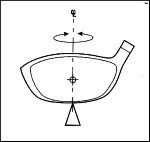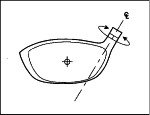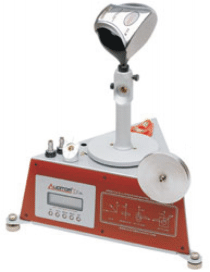WHAT IS moment of inertia ANYWAY?
Just what is moment of inertia? It is basically the property of an object to resist rotation about a given axis.
To understand MOI, think of a spinning ice skater. At the beginning of the spin, the skater extends her arms and the rotation speed is slow. As the skater pulls her arms in closer to her body, the speed of the spin greatly increases. Thus when the arms are extended, the skater’s Moment of Inertia is very high, and the result is a slower spin because the high MOI of the skater is resisting the speed of rotation. Conversely, the reason the spin speed increases when the skater pulls in her arms is that as the arms get closer to her body, the skater's MOI falls lower and lower, creating little resistance to the rotation.
M.O.I. in your golf equipment, specifically your golf driver, is the resistance to twisting when the club head impacts the golf ball. In order to get the most distance and accuracy, your goal is to hit every shot in the “sweet spot”-the absolute center of the striking surface. However, if contact is NOT on the sweet spot, the driver head will start to twist, and the ball will either loose distance, or you will hit a slice or cut, depending on where the impact occurs. High moi driver heads are designed to twist less at impact and thus are more forgiving than lower moi heads.

We are not going to get into a “Sir Isaac Newton” explanation regarding moment of inertia, but if you hang in with us, we will try to explain in simple terms how MOI applies to your driver head. The graphic to the right shows the vertical axis of the driver head going directly through the head’s center of gravity. This is referred to as the MOI Izz, and is the only pertinent measurement used concerning your driver head.

The other moment of inertia in woodheads that has some bearing to shot performance is the MOI about the axis of the shaft, as seen in the graphic to the right. In clubhead performance the woodhead also has to rotate about the axis of the shaft during the downswing. The higher the MOI of the woodhead about the shaft, the more resistance the head will provide to the golfer’s rotation of the face back around to square on the downswing. Refer to our pages on SHAFTS for further information, but for now we are only concerned with the MOI Izz.
U.S.G.A MOI LIMIT
Moment of Inertia is a physical property that can be expressed as a numerical measurement. That's not a number that is common to see (yet) in golf clubs. However, the term "moment of inertia" or "MOI" is becoming much more common in advertising and marketing by the golf club companies.
On May 1st, 2006, the U.S.G.A. implemented a rule to limit the MOI of a driver head to 5900 gm-cm sq. plus a tolerance of 100 gm-cm sq. making the absolute maximum driver head MOI 6000 gm-cm sq.
The measurement for modern day drivers is a function of five basic mass and dimensional properties; head size, head weight, material, shape, and center of gravity location. Since head size is limited by the USGA and the head weight is dictated by the swingweight we desire, this leaves shape, materials, and center of gravity location as the easiest variables to significantly modify to achieve higher driver MOI. This is why you are seeing square heads and movable weight insertions to change the center of gravity and different materials being used on all the new drivers appearing on the market.
If you want to find out how MOI of a driver head is calculated mathematically, please do your research on the internet. For our purposes, the graphic below shows the machine used by the USGA and all reputable club designers to measure the MOI of a driver head.

What does this mean to to-days golfers when they are selecting that all important driver head?
Current research and study shows that with current technology it would be very difficult to achieve MOIs higher than 5400 gm-cm sq. Achieving the USGA limit of 5900 gm-cm sq. + will require new head manufacturing technology and/or new head materials to be developed. This is already being accomplished and will only get more advanced in the years to come.
Therefore, one should play a driver with a moment of inertia of >5000 gm-cm sq., with a variable thickness face design that will ensure the smallest decrease in COR from center to off-center hit locations, shafted with a stable, fitted to length, proper flexed shaft. You can also add loft, face angle, swingweight and grip size to the equation.
When it comes to new technology, be smart and focus on the total benefits of full custom fitting rather than hyped up individual club head marketing claims.
Return to Driver Head Return to Home Page